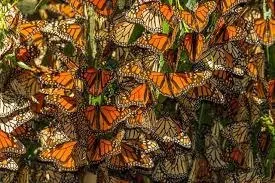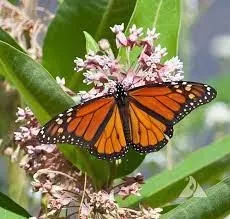Some Good News for Western Monarch Butterflies…maybe
By Susan Mora Loyko, Master Gardener
There was more than turkey to be thankful for last November at the 25th Annual Xerces Society's Western Monarch Thanksgiving Count held in Pacific Grove. After several years of the butterflies' declining numbers, the final count was about 250,000. The 2020 butterfly count marked an all-time low of less than 2,000 Monarchs.
Monarchs living west of the Rocky Mountain overwinter in California along the Mendocino Coast and are known to gather in giant clusters of Eucalyptus, Monterey Pines, and Monterey Cypresses, as far south as Baja.
While scientists, volunteers, and lovers of the Monarchs were thrilled in the increased butterfly numbers, there was also concern the rise could be a fluke. The migratory butterflies had a steady decline for the last several years with populations at more than 95% below those of the 1980s.
The decrease began in 2017, a year of unusual heat at critical times of the year with long periods of temperatures more than 90°, unfavorable to butterfly eggs according to Dr. Chip Taylor, Professor Emeritus of Ecology and Evolutionary Biology, University of Kansas, and Director of Monarch Watch. He said the recent rise in temperatures across the country have been linked with declining butterfly populations, particularly on the West Coast where temperatures have been rising 0.7 degrees per decade since 1975.
Monarchs also have many natural enemies. Predators such as spiders and fire ants kill and eat Monarch eggs and caterpillars. Some birds and wasps feed on the adult butterflies. Monarchs also suffer attacks from parasites, organisms living inside their bodies.
Data from the annual butterfly count, along with monitoring twice during the overwintering season, allows researchers to observe how Monarchs are using overwintering sites: some sites host Monarchs all winter, while others are transitional sites. It's important to note they continue to face threats and require more monitoring to better understand their risks and what conservation efforts are still needed to recover.
Why should we care about the health and future of the Monarch Butterflies and other pollinators? Their flight across the country (along with bees and other small insects) are essential to our ecosystem to pollinate flowers, fruits, and vegetables and ultimately our larger food systems.
Each spring, Monarchs leave overwintering sites and disperse across California first, and eventually migrate to all western states, searching for milkweed plants on which to lay their eggs. It is the only plant Monarch caterpillars can eat to develop into adults.

Milkweeds (Asclepias spp.) are required important host plants for Monarch caterpillars in their life cycle. The loss of milkweed plants in the Monarch's spring and summer breeding areas across the country is believed to be a significant factor contributing to their reduced numbers in California/Mexico overwintering sites. Agricultural intensification, development of rural lands, mowing, and herbicides to control roadside vegetation also contribute to the milkweed loss.
Here are Xerces Society recommendations to help the Monarchs:
- Plant native milkweed in your backyard, workplace, or school. If outside of native milkweed's historic range, Xerces recommends planting fall, winter, and spring blooming nectar sources INSTEAD of milkweed.
- Plant a diversity of native flowers. Monarchs need nectar to provide energy to migrate, breed, and overwinter. Nectar plants can be planted anywhere.
- Support organic and GMO-free agriculture.
Avoid using pesticides. These may kill butterflies, caterpillars and plants used for nectar or breeding. - Get involved in community science projects.

